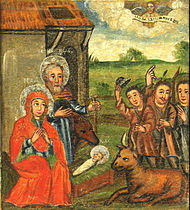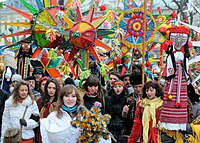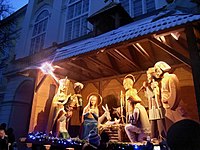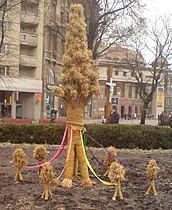Christmas in Ukraine
| Christmas in Ukraine | |
|---|---|
 Twelve-dish Christmas Eve supper by Jacques Hnizdovsky | |
| Also called | Rizdvo |
| Observed by | Christians, many non-Christians |
| Type | Christian, cultural |
| Significance | Commemoration of the Nativity of Jesus |
| Celebrations | Gift-giving, family and other social gatherings, symbolic decoration, feasting etc. |
| Observances | Church services |
| Date |
|
| Frequency | Annual |
Traditional Ukrainian Christmas festivities start on Christmas Eve, which is celebrated on 6 January, as reckoned by the Julian calendar. The Christmas celebrations end on 19 January, the date of Epiphany, or Yordan in Ukrainian, by the Julian calendar.[4]
As of 2017, 25 December, Christmas day by the Gregorian calendar, became an official government holiday in Ukraine. The Eastern Orthodox Church and Ukrainian Greek Catholic Churches predominantly follow the Julian Calendar, and 7 January is also a public holiday in Ukraine.[5][6] In December 2020, the head of the Orthodox Church of Ukraine, Metropolitan Epiphanius, said that changing the date of Christmas to 25 December in Ukraine is possible after both the church and the faithful are ready for such a decision, after conducting educational work. It was stated that the postponement of the Nativity of the Lord would entail a change in the dates of all fixed holidays to 13 days ago.[7] In December 2020, the head of the UGCC, Patriarch Sviatoslav, stated that the Greek Catholic Church would resolve this issue "together with our Orthodox brothers." He also noted that this issue is not dogmatic, it should overcome church divisions, not cause new ones, and in his opinion, the transition to celebrating Christmas in a new style — 25 December, should be initiated by the laity.
Sviatyi Vechir (Holy Evening)[]
Christmas Eve, or as its called Sviatyi Vechir or Sviatvechir in Ukrainian ("Holy Evening") is filled with numerous customs and rituals. Traditions include decorating house and dinner table with special attributes (a symbolic sheaf of wheat called the didukh, garlic, hay, and others), performing koliadky ('carols') and so on. Each ritual has its own meaning and purpose, as such a few wisps of hay on the embroidered tablecloth as a reminder of the manger in Bethlehem. One prominent customs of the night is a special supper, called Sviata Vecheria ("Holy Supper").[citation needed]
Whole family brings together to have a dinner which includes 12 dishes. These twelve dishes traditionally do not contain meat, milk, or eggs when served for this meal. [8]Kutia (sweet grain pudding) is traditionally served at the Ukrainian Christmas dinner table. It is often the first dish in the traditional twelve-dish Christmas-Eve supper and is rarely served at other times of the year.[9]
Koliadky (Caroling)[]
At the end of the Sviata Vechera the family often sings carols (koliadky, singular koliadka). In many communities the ancient Ukrainian tradition of caroling is carried on by groups of young people and members of organizations and churches calling at homes and collecting donations. Well-known carol is "Boh predvichnyi narodyvsia".[10]
Didukh (Grandfather)[]
When the children see the first star in the eastern evening sky, the dinner may begin. In farming communities the head of the household brings in a sheaf of wheat called the didukh which represents the importance of the ancient and rich wheat crops of Ukraine, the staff of life through the centuries. Didukh means literally "grandfather spirit" so it symbolizes the family's ancestors. In city homes a few stalks of golden wheat in a vase are often used to decorate the table, they also decorate the dinner table with garlic.
Shopka (Nativity scene)[]
A shopka is a traditional portable nativity scene used to represent nativity and other figures in a puppet form.
Gallery[]

2006 Christmas stamp, showing St. Nicholas and children

Religious painting showing the Adoration of the Shepherds

Caroling in Lviv

Nativity scene

A didukh in Lviv
Further reading[]
- Kutia, Star of the Ukrainian Christmas Eve Supper
- Kylymnyk, Stepan, 1955–1969; Ukrainskyi Rik u Narodnykh Zvychayakh v Narodnomu Osvitlenni [Ukrainian Year in Folk Customs from Historical Perspective], Winnipeg, Toronto
- Tracz, Orysia 2015, First Star I See Tonight, Mazepa Publications Zhuravli, Winnipeg
- Ukrainian Christmas Traditions, Ukrainian International Directory
- Voropai, Oleksa 1958, Zvychai Nashoho Narodu [Customs of Our People], Ukrainske Vydavnytstvo, Munich
- Yakovenko, Svitlana 2016, Ukrainian Christmas Eve Supper: Traditional village recipes for Sviata Vecheria, Sova Books, Sydney
See also[]
References[]
- ^ Martindale, Cyril Charles (1908). "Christmas". The Catholic Encyclopedia. 3. New York: Robert Appleton Company.
- ^ Gwynne, Paul (2011). World Religions in Practice. John Wiley & Sons. ISBN 978-1-4443-6005-9.
- ^ Ramzy, John. "The Glorious Feast of Nativity: 7 January? 29 Kiahk? 25 December?". Coptic Orthodox Church Network. Archived from the original on 28 December 2010. Retrieved 17 January 2011.
- ^ Christmas Traditions
- ^ "Ukraine seeks distance from Moscow with new Christmas holiday". m.digitaljournal.com. Retrieved 16 November 2017.
- ^ (in Ukrainian) "Рада зробила 25 грудня вихідним днем". BBC Україна. 16 November 2017. Retrieved 16 November 2017.
- ^ https://news.rbc.ua/ukr/politics/epifaniy-nazval-uslovie-perenosa-prazdnovaniya-1608382147.html
- ^ "Christmas in Ukraine". Why Christmas. Retrieved 14 December 2020.
- ^ Sviat Vechir
- ^ "Boh predvičnyj". Metropolitan Cantor Institute. Byzantine Catholic. Retrieved 12 August 2015.
- Ukrainian culture
- Christmas traditions by country
- Ukrainian traditions
- Public holidays in Ukraine
- January observances
- Slavic Christmas traditions
- Ukrainian culture stubs





